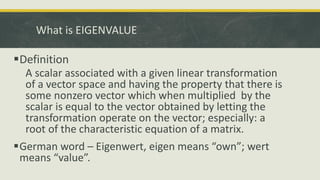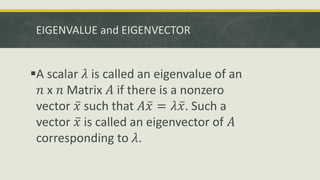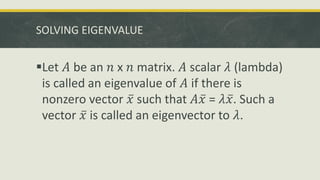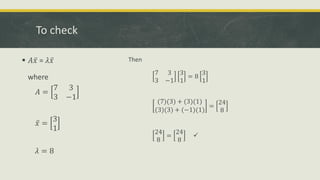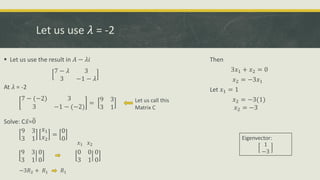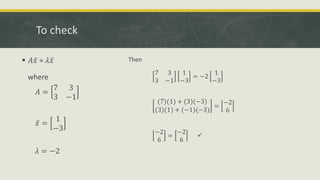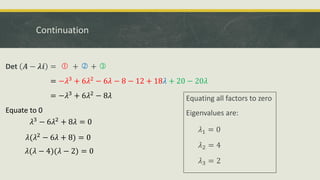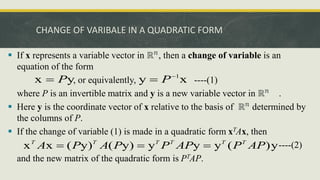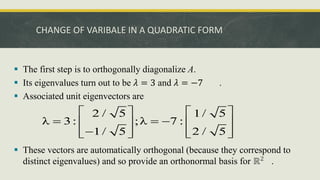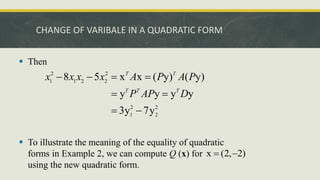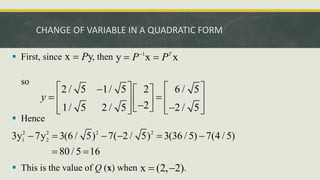Eigenvalues, Eigenvectors and Quadratic Forms.pdf
- 1. Eigenvalue Problems and Quadratic Forms ENGINEERING MATHEMATICS By: Engr. Angelo Ramos, LPT, MEng
- 2. What is EIGENVALUE ’é¦Definition A scalar associated with a given linear transformation of a vector space and having the property that there is some nonzero vector which when multiplied by the scalar is equal to the vector obtained by letting the transformation operate on the vector; especially: a root of the characteristic equation of a matrix. ’é¦German word ŌĆō Eigenwert, eigen means ŌĆ£ownŌĆØ; wert means ŌĆ£valueŌĆØ.
- 3. EIGENVALUE and EIGENVECTOR ’é¦A scalar Ø£å is called an eigenvalue of an Øæø x Øæø Matrix ØÉ┤ if there is a nonzero vector ę¦ Øæź such that ØÉ┤ ę¦ Øæź = Ø£å ę¦ Øæź. Such a vector ę¦ Øæź is called an eigenvector of ØÉ┤ corresponding to Ø£å.
- 5. SOLVING EIGENVALUE ’é¦Let ØÉ┤ be an Øæø x Øæø matrix. ØÉ┤ scalar Ø£å (lambda) is called an eigenvalue of ØÉ┤ if there is nonzero vector ę¦ Øæź such that ØÉ┤ ę¦ Øæź = Ø£å ę¦ Øæź. Such a vector ę¦ Øæź is called an eigenvector to Ø£å.
- 6. SOLVING EIGENVALUE ’é¦The Process To solve for the eigenvalues, Ø£åØæ¢, and the corresponding eigenvector, ę¦ ØæźØæ¢ of an Øæø x Øæø matrix ØÉ┤, do the following: 1. Multiply an Øæø x Øæø identity matrix by the scalar Ø£å. 2. Subtract the identity matrix multiple from the matrix ØÉ┤. 3. Find the determinants of the matrix and the difference. 4. Solve for the values of Ø£å that satisfy the equation det ØÉ┤ ŌłÆ Ø£åi = Ó┤ż 0. 5. Solve for the corresponding eigenvector to each Ø£å.
- 7. FINDING THE EIGENVALUES Example: Find the Eigenvalue of the Matrix A below ØÉ┤ = 7 3 3 ŌłÆ1 ’é¦ Multiply Ø£å by Øæ¢ (identity matrix) Ø£åØæ¢ = Ø£å 1 0 0 1 = Ø£å 0 0 Ø£å ’é¦ Subtract the identity matrix multiple from the matrix ØÉ┤ ØÉ┤ ŌłÆ Ø£åØæ¢ = 7 3 3 ŌłÆ1 ŌłÆ Ø£å 0 0 Ø£å = 7 ŌłÆ Ø£å 3 3 ŌłÆ1 ŌłÆ Ø£å ’é¦ Get the determinants of the matrix and find the difference. dØæÆØæĪ 7 ŌłÆ Ø£å 3 3 ŌłÆ1 ŌłÆ Ø£å then = (7 ŌłÆ Ø£å)(ŌłÆ 1 ŌłÆ Ø£å) ŌłÆ(3)(3) = ŌłÆ7 ŌłÆ 7Ø£å+ Ø£å+ Ø£å2 ŌłÆ 9 = Ø£å2 ŌłÆ 6Ø£å ŌłÆ 16 ’é¦ Solve for the values of Ø£å that satisfy the equation det ØÉ┤ ŌłÆ Ø£åi = Ó┤ż 0 So Ø£å2 ŌłÆ 6Ø£å ŌłÆ 16 = 0 Then by factoring (Ø£å ŌłÆ 8)(Ø£å + 2) = 0 ie: Ø£å = 8 Ø£å = ŌłÆ 2 Eigenvalues
- 8. FINDING THE EIGENVECTORS ’é¦ Let us use the result in ØÉ┤ ŌłÆ Ø£åØæ¢ 7 ŌłÆ Ø£å 3 3 ŌłÆ1 ŌłÆ Ø£å At Ø£å = 8 7 ŌłÆ 8 3 3 ŌłÆ1 ŌłÆ 8 = ŌłÆ1 3 3 ŌłÆ9 Solve: ØÉĄ ę¦ Øæź=Ó┤ż 0 ŌłÆ1 3 3 ŌłÆ9 Øæź1 Øæź2 = 0 0 ßēÜ ŌłÆ1 3 3 ŌłÆ9 0 0 Then ŌłÆØæź1 + 3Øæź2 = 0 3Øæź2 = Øæź1 Let Øæź2 = 1 3(1) = Øæź1 Øæź1 = 3 Let us call this Matrix B 3Øæģ1 + Øæģ2 Øæģ2 ßēÜ ŌłÆ1 3 0 0 0 0 Øæź1 Øæź2 Eigenvector: 3 1
- 9. To check ’é¦ ØÉ┤ ę¦ Øæź = Ø£å ę¦ Øæź where ØÉ┤ = 7 3 3 ŌłÆ1 ę¦ Øæź = 3 1 Ø£å = 8 Then 7 3 3 ŌłÆ1 3 1 = 8 3 1 (7)(3) + (3)(1) (3)(3) + (ŌłÆ1)(1) = 24 8 24 8 = 24 8 ’ā╝
- 10. Let us use Ø£å = -2 ’é¦ Let us use the result in ØÉ┤ ŌłÆ Ø£åØæ¢ 7 ŌłÆ Ø£å 3 3 ŌłÆ1 ŌłÆ Ø£å At Ø£å = -2 7 ŌłÆ (ŌłÆ2) 3 3 ŌłÆ1 ŌłÆ (ŌłÆ2) = 9 3 3 1 Solve: C ę¦ Øæź=Ó┤ż 0 9 3 3 1 Øæź1 Øæź2 = 0 0 ßēÜ 9 3 3 1 0 0 Then 3Øæź1 + Øæź2 = 0 Øæź2 = ŌłÆ3Øæź1 Let Øæź1 = 1 Øæź2 = ŌłÆ3(1) Øæź2 = ŌłÆ3 Let us call this Matrix C ŌłÆ3Øæģ2 + Øæģ1 Øæģ1 ßēÜ 0 0 3 1 0 0 Øæź1 Øæź2 Eigenvector: 1 ŌłÆ3
- 11. To check ’é¦ ØÉ┤ ę¦ Øæź = Ø£å ę¦ Øæź where ØÉ┤ = 7 3 3 ŌłÆ1 ę¦ Øæź = 1 ŌłÆ3 Ø£å = ŌłÆ2 Then 7 3 3 ŌłÆ1 1 ŌłÆ3 = ŌłÆ2 1 ŌłÆ3 (7)(1) + (3)(ŌłÆ3) (3)(1) + (ŌłÆ1)(ŌłÆ3) = ŌłÆ2 6 ŌłÆ2 6 = ŌłÆ2 6 ’ā╝
- 12. Another example ’é¦ Show that ę¦ Øæź = 2 1 is an eigenvector of ØÉ┤ = 3 2 3 ŌłÆ2 corresponding to Ø£å = 4. ØÉ┤ ę¦ Øæź = Ø£å ę¦ Øæź 3 2 3 ŌłÆ2 2 1 = 4 2 1 3 2 + (2)(1) 3 2 + (ŌłÆ2)(1) = 8 4 8 4 = 8 4 Note: If Ø£å is an eigenvalue of ØÉ┤, and ę¦ Øæź is an eigenvector belonging to Ø£å, any nonzero multiple of ę¦ Øæź will be an eigenvector
- 13. Find the Eigenvalue of this 3 x 3 matrix ØÉ┤ = 4 6 10 3 10 13 ŌłÆ2 ŌłÆ6 ŌłÆ8 SolŌĆÖn Det ØÉ┤ ŌłÆ Ø£åØæ¢ = 4 6 10 3 10 13 ŌłÆ2 ŌłÆ6 ŌłÆ8 ŌłÆ Ø£å 1 0 0 0 1 0 0 0 1 = 4 ŌłÆ Ø£å 6 10 3 10 ŌłÆ Ø£å 13 ŌłÆ2 ŌłÆ6 ŌłÆ8 ŌłÆ Ø£å = 4 ŌłÆ Ø£å 10 ŌłÆ Ø£å 13 ŌłÆ6 ŌłÆ8 ŌłÆ Ø£å ŌłÆ 6 3 13 ŌłÆ2 ŌłÆ8 ŌłÆ Ø£å + (10) 3 10 ŌłÆ Ø£å ŌłÆ2 ŌłÆ6
- 14. Det Øæ© ŌłÆ ØØĆØÆŖ = Ø¤Æ ŌłÆ ØØĆ Ø¤ÅØ¤Ä ŌłÆ ØØĆ ŌłÆؤ¢ ŌłÆ ØØĆ ŌłÆ ŌłÆؤö ؤÅؤæ ŌłÆ ؤö ؤæ ŌłÆؤ¢ ŌłÆ ØØĆ ŌłÆ ؤÅؤæ ŌłÆØ¤É +(ؤÅؤÄ) ؤæ ŌłÆؤö ŌłÆ (ŌłÆؤÉ)(ؤÅØ¤Ä ŌłÆ ØØĆ Continuation (4 ŌłÆ Ø£å)(ŌłÆ80 ŌłÆ 10Ø£å + 8Ø£å + Ø£å2 + 78) = (4 ŌłÆ Ø£å)(ŌłÆ2 ŌłÆ 2Ø£å + Ø£å2 ) = ŌłÆ8 ŌłÆ 8Ø£å + 4Ø£å2 + 2Ø£å + 2Ø£å2 ŌłÆ Ø£å3 = ŌłÆØ£å3 + 6Ø£å2 ŌłÆ 6Ø£å ŌłÆ 8 ’éü ’éé ’éā ’éü (ŌłÆ6)(ŌłÆ24 ŌłÆ 3Ø£å + 26) = (ŌłÆ6)(2 ŌłÆ 3Ø£å) = ŌłÆ12 + 18Ø£å ’éé (10)(ŌłÆ18 + 20 ŌłÆ 2Ø£å) = (10)(2 ŌłÆ 2Ø£å) = 20 ŌłÆ 20Ø£å ’éā
- 15. Det Øæ© ŌłÆ ØØĆØÆŖ = + + = ŌłÆØ£å3 + 6Ø£å2 ŌłÆ 6Ø£å ŌłÆ 8 ŌłÆ 12 + 18Ø£å + 20 ŌłÆ 20Ø£å = ŌłÆØ£å3 + 6Ø£å2 ŌłÆ 8Ø£å Equate to 0 Ø£å3 ŌłÆ 6Ø£å2 + 8Ø£å = 0 Ø£å(Ø£å2 ŌłÆ 6Ø£å + 8) = 0 Ø£å(Ø£å ŌłÆ 4)(Ø£å ŌłÆ 2) = 0 Continuation ’éé ’éā ’éü Equating all factors to zero Eigenvalues are: Ø£å1 = 0 Ø£å2 = 4 Ø£å3 = 2
- 16. Quadratic Forms
- 17. QUADRATIC FORMS ’é¦ A quadratic form on ŌäØØæø is a function Q defined on ŌäØØæø whose value at a vector x in ŌäØØæø can be computed by an expression of the form ØƼ Øæź = ØæźØæć ØÉ┤Øæź, where A is an Øæø x Øæø symmetric matrix. ’é¦ The matrix A is called the matrix of the quadratic form.
- 18. Quadratic Forms ’é¦ Example 1: Let . Compute xTAx for the following matrices. a. b. 1 2 x x x ’ā® ’ā╣ ’ĆĮ ’ā¬ ’ā║ ’ā½ ’ā╗ 4 0 0 3 A ’ā® ’ā╣ ’ĆĮ ’ā¬ ’ā║ ’ā½ ’ā╗ 3 2 2 7 A ’ĆŁ ’ā® ’ā╣ ’ĆĮ ’ā¬ ’ā║ ’ĆŁ ’ā½ ’ā╗
- 19. QUADRATIC FORMS ’é¦ Solution: a. . b. There are two -2 entries in A. ’üø ’üØ ’üø ’üØ 1 1 2 2 1 2 1 2 1 2 2 2 4 4 0 x x 4 3 3 0 3 T x x A x x x x x x x x ’ā® ’ā╣ ’ā® ’ā╣ ’ā® ’ā╣ ’ĆĮ ’ĆĮ ’ĆĮ ’Ć½ ’ā¬ ’ā║ ’ā¬ ’ā║ ’ā¬ ’ā║ ’ā½ ’ā╗ ’ā½ ’ā╗ ’ā½ ’ā╗ ’üø ’üØ ’üø ’üØ 1 1 2 1 2 1 2 2 1 2 1 1 2 2 1 2 2 2 1 1 2 2 1 2 2 2 1 1 2 2 3 2 3 2 x x 2 7 2 7 (3 2 ) ( 2 7 ) 3 2 2 7 3 4 7 T x x x A x x x x x x x x x x x x x x x x x x x x x x x ’ĆŁ ’ĆŁ ’ā® ’ā╣ ’ā® ’ā╣ ’ā® ’ā╣ ’ĆĮ ’ĆĮ ’ā¬ ’ā║ ’ā¬ ’ā║ ’ā¬ ’ā║ ’ĆŁ ’Ć½ ’ĆŁ ’ā½ ’ā╗ ’ā½ ’ā╗ ’ā½ ’ā╗ ’ĆĮ ’ĆŁ ’Ć½ ’ĆŁ ’Ć½ ’ĆĮ ’ĆŁ ’ĆŁ ’Ć½ ’ĆĮ ’ĆŁ ’Ć½
- 20. QUADRATIC FORMS ’é¦ The presence of in the quadratic form in Example 1(b) is due to the -2 entries off the diagonal in the matrix A. ’é¦ In contrast, the quadratic form associated with the diagonal matrix A in Example 1(a) has no x1x2 cross- product term. 1 2 4x x ’ĆŁ
- 21. CHANGE OF VARIBALE IN A QUADRATIC FORM ’é¦ If x represents a variable vector in ŌäØØæø , then a change of variable is an equation of the form , or equivalently, ----(1) where P is an invertible matrix and y is a new variable vector in ŌäØØæø . ’é¦ Here y is the coordinate vector of x relative to the basis of ŌäØØæø determined by the columns of P. ’é¦ If the change of variable (1) is made in a quadratic form xTAx, then ----(2) and the new matrix of the quadratic form is PTAP. x y P ’ĆĮ 1 y x P’ĆŁ ’ĆĮ x x ( y) ( y) y y y ( )y T T T T T T A P A P P AP P AP ’ĆĮ ’ĆĮ ’ĆĮ
- 22. CHANGE OF VARIBALE IN A QUADRATIC FORM ’é¦ Since A is symmetric, Theorem 2 guarantees that there is an orthogonal matrix P such that PTAP is a diagonal matrix D, and the quadratic form in (2) becomes yTDy. ’é¦ Example 2: Make a change of variable that transforms the quadratic form into a quadratic form with no cross- product term. ’é¦ Solution: The matrix of the given quadratic form is 2 2 1 1 2 2 (x) 8 5 Q x x x x ’ĆĮ ’ĆŁ ’ĆŁ 1 4 4 5 A ’ĆŁ ’ā® ’ā╣ ’ĆĮ ’ā¬ ’ā║ ’ĆŁ ’ĆŁ ’ā½ ’ā╗
- 23. CHANGE OF VARIBALE IN A QUADRATIC FORM ’é¦ The first step is to orthogonally diagonalize A. ’é¦ Its eigenvalues turn out to be Ø£å = 3 and Ø£å = ŌłÆ7 . ’é¦ Associated unit eigenvectors are ’é¦ These vectors are automatically orthogonal (because they correspond to distinct eigenvalues) and so provide an orthonormal basis for ŌäØ2 . 2 / 5 1/ 5 ╬╗ 3: ;╬╗ 7 : 1/ 5 2 / 5 ’ā® ’ā╣ ’ā® ’ā╣ ’ĆĮ ’ĆĮ ’ĆŁ ’ā¬ ’ā║ ’ā¬ ’ā║ ’ĆŁ ’ā¬ ’ā║ ’ā¬ ’ā║ ’ā½ ’ā╗ ’ā½ ’ā╗
- 24. CHANGE OF VARIBALE IN A QUADRATIC FORM ’é¦ Let ’é¦ Then and . ’é¦ A suitable change of variable is ,where and . 2 / 5 1/ 5 3 0 , 0 7 1/ 5 2 / 5 P D ’ā® ’ā╣ ’ā® ’ā╣ ’ĆĮ ’ĆĮ ’ā¬ ’ā║ ’ā¬ ’ā║ ’ĆŁ ’ĆŁ ’ā½ ’ā╗ ’ā¬ ’ā║ ’ā½ ’ā╗ 1 A PDP’ĆŁ ’ĆĮ 1 T D P AP P AP ’ĆŁ ’ĆĮ ’ĆĮ x y P ’ĆĮ 1 2 x x x ’ā® ’ā╣ ’ĆĮ ’ā¬ ’ā║ ’ā½ ’ā╗ 1 2 y y y ’ā® ’ā╣ ’ĆĮ ’ā¬ ’ā║ ’ā½ ’ā╗
- 25. CHANGE OF VARIBALE IN A QUADRATIC FORM ’é¦ Then ’é¦ To illustrate the meaning of the equality of quadratic forms in Example 2, we can compute Q (x) for using the new quadratic form. 2 2 1 1 2 2 2 2 1 2 8 5 x x ( y) ( y) y y y y 3y 7y T T T T T x x x x A P A P P AP D ’ĆŁ ’ĆŁ ’ĆĮ ’ĆĮ ’ĆĮ ’ĆĮ ’ĆĮ ’ĆŁ x (2, 2) ’ĆĮ ’ĆŁ
- 26. CHANGE OF VARIABLE IN A QUADRATIC FORM ’é¦ First, since , then so ’é¦ Hence ’é¦ This is the value of Q (x) when . x y P ’ĆĮ 1 y x x T P P ’ĆŁ ’ĆĮ ’ĆĮ 2 / 5 1/ 5 2 6 / 5 2 1/ 5 2 / 5 2 / 5 y ’ā® ’ā╣ ’ā® ’ā╣ ’ĆŁ ’ā® ’ā╣ ’ĆĮ ’ĆĮ ’ā¬ ’ā║ ’ā¬ ’ā║ ’ā¬ ’ā║ ’ĆŁ ’ĆŁ ’ā½ ’ā╗ ’ā¬ ’ā║ ’ā¬ ’ā║ ’ā½ ’ā╗ ’ā½ ’ā╗ 2 2 2 2 1 2 3y 7y 3(6 / 5) 7( 2 / 5) 3(36 / 5) 7(4 / 5) 80 / 5 16 ’ĆŁ ’ĆĮ ’ĆŁ ’ĆŁ ’ĆĮ ’ĆŁ ’ĆĮ ’ĆĮ x (2, 2) ’ĆĮ ’ĆŁ

